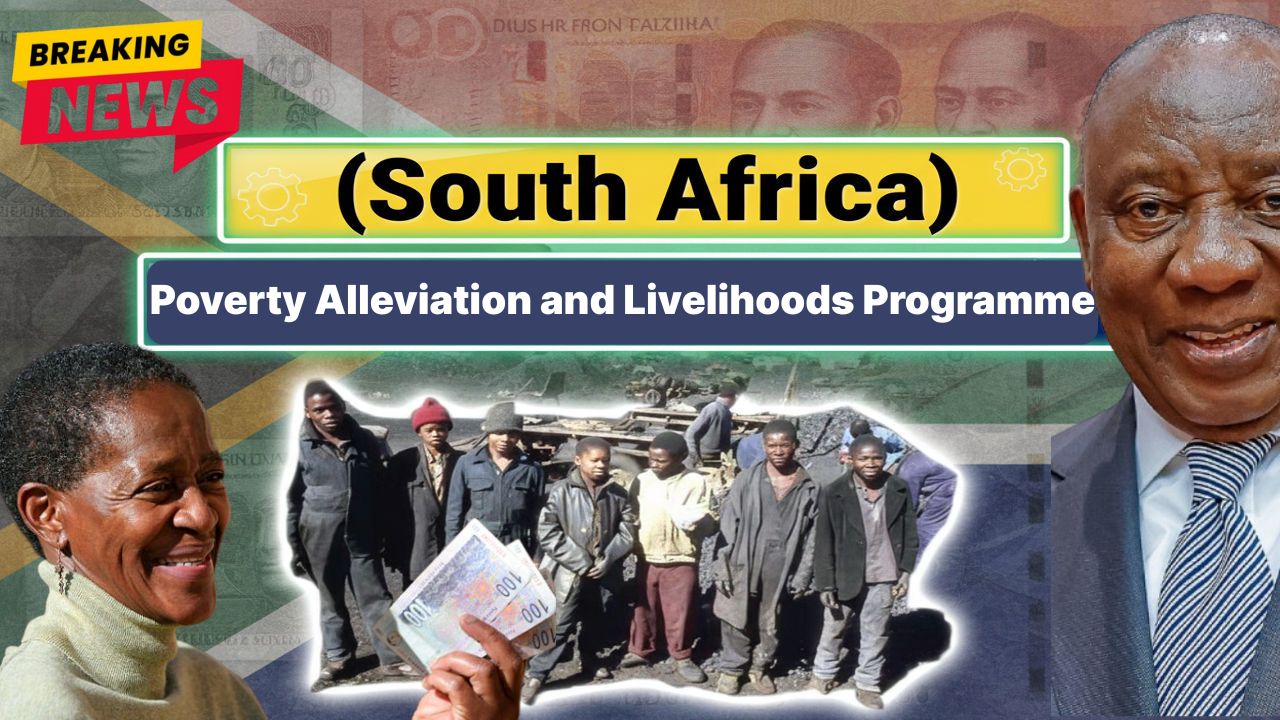In South Africa, persistent poverty and unemployment remain urgent social and economic concerns. To address these issues, the government has developed the Poverty Alleviation and Livelihoods Programme, a multidimensional initiative designed to reduce poverty, create sustainable livelihoods and strengthen household resilience. This article offers a polished, research-based discussion of the programme, its structure, how it works, who it supports, and how individuals and communities can participate.
Poverty Alleviation and Livelihoods Programme Summary Table
Field |
Details |
|---|---|
Name |
Poverty Alleviation and Livelihoods Programme |
Country |
South Africa |
Purpose |
To reduce poverty and enable households to build sustainable livelihoods through support, training, enterprise development, and asset-building interventions |
Key Components |
Income support or temporary work placements; skills training and capacity development; micro-enterprise or small business support; community-based asset and service development; livelihood diversification |
Target Groups |
Poor and vulnerable households, unemployed or under-employed individuals, youth, women, persons with disabilities, rural and peri-urban communities |
Delivery Mechanism |
Government departments (Social Development, Human Settlements, Cooperative Governance etc.), local municipalities, Non-Profit Organisations (NPOs), community-based organisations (CBOs) and partnerships with private sector and donors |
Official Site |
https://www.gov.za/issues/poverty-alleviation (or relevant Government portal) |
Participation Route |
Eligibility based on poverty or unemployment status; registration via local social development offices or implementing partners; selection for training, placements, enterprise support; follow-up support for livelihood integration |
Expected Outcomes |
Household income enhancement, improved employability, enterprise creation, local economic activity, reduction in poverty incidence and improved living standards |
Key Focus Areas |
Skills and livelihoods, enterprise development, community asset creation, women and youth empowerment, transition from dependency to self-sufficiency |
Why the Programme Was Introduced
Despite improvements in some economic indicators, many South African households continue to endure poverty, unemployment or under-employment, particularly in rural and marginalised areas. Poverty is not simply the lack of income it also reflects limited access to assets, skills, services and economic opportunities. The Poverty Alleviation and Livelihoods Programme was introduced to address these multidimensional aspects of poverty by shifting from purely welfare or relief approaches to an integrated model emphasising livelihoods. The objective is to support vulnerable households not only to survive but to build capabilities, diversify income sources and actively participate in the economy.
How the Programme Works
Income Support and Temporary Work
One component offers temporary employment or structured work opportunities tied to public‐works, community services or asset creation tasks. These placements provide immediate income, work experience and link participants to training and future opportunities.
Skills Training and Capacity Development
Parallel to placements or enterprise support, participants receive training in vocational skills, business development, financial literacy and workplace readiness. This training enables them to move toward sustainable livelihoods rather than just short‐term relief.
Micro-Enterprise and Small Business Support
A key pillar is assisting households or individuals to start or expand micro-enterprises. Support may include seed grants, mentoring, business development services, market access facilitation and linkages with supply chains. The programme emphasises entrepreneurship, especially among women and youth.
Community Asset Creation and Local Initiatives
Some interventions focus on building local assets such as infrastructure repairs, environmental work, service delivery that both improve the local environment and provide livelihood opportunities. By integrating work with asset creation, the programme delivers public goods while supporting vulnerable workers.
Institutional Partnerships and Delivery Channels
Government, local municipalities, NGOs and other partners collaborate to implement the programme. Local registration centres, social development offices and community organisations identify eligible households, conduct selection, monitor participation and provide ongoing support. Monitoring and evaluation frameworks seek to track outcomes in income, employment, enterprise creation and poverty reduction.
Eligibility and Participation
Who Can Participate?
Participants are typically drawn from poor and vulnerable households, unemployed or under-employed individuals, youth (especially 18-34), women, persons with disabilities, and residents of economically disadvantaged communities. Criteria may include means‐testing, proof of residence, and willingness to engage in the intervention.
How to Get Involved
- Identify the local implementing agency (municipal social development office, NGO partner, community organisation).
- Register your interest and provide required documentation (identity, residence, income status).
- Attend information sessions or orientations when selections are announced.
- If selected, participate in the placement, training or enterprise support component and adhere to agreed conditions.
- Receive follow-up support for transition into other work or business activity.
Benefits for Participants
- Immediate income or stipend, helping relieve poverty pressures.
- Work experience, enhancing employability and personal confidence.
- Training and skills that support longer-term livelihood options.
- Opportunity to start or grow a small business or participate in local economic activity.
- Access to networks and ongoing support from implementing partners.
Impact and Early Outcomes
Early implementation has shown promising results: participating households report some income improvements, work placements provide meaningful experience and trainees are better positioned for future opportunities. Local asset creation enhances community infrastructure and contributes to local economies. The livelihoods approach shifts focus from dependency to agency: beneficiaries become producers and entrepreneurs rather than passive aid recipients.
Advantages and Key Strengths
- Integrative approach: combines income, skills, assets and entrepreneurship.
- Focus on vulnerable groups and inclusive growth.
- Builds local capacity and engages community stakeholders.
- Provides a pathway from poverty relief to sustainable livelihoods.
- Supports economic participation and local asset development.
Challenges and Limitations
There are notable challenges:
- Temporary nature of many placements means risk of return to poverty if transition pathways are weak.
- Ensuring training is aligned with actual labour-market or business opportunities is complex.
- Enterprise support must overcome market access, capital and business environment barriers.
- Monitoring long-term outcomes (income growth, employment stability) remains challenging.
- Structural poverty issues (education, transport, health) still constrain full impact.
- Funding, coordination and institutional capacity vary by region, affecting consistency of delivery.
Strategic Directions for the Future
To maximise impact, the programme continues to evolve with strategic priorities such as:
- Strengthening links to formal employment, value chains and enterprise markets.
- Enhancing monitoring and data systems to track long-term livelihood outcomes.
- Encouraging private‐sector partnerships to absorb participants and support enterprises.
- Improving training relevance, soft skills and digital capabilities.
- Addressing structural barriers such as transport, health, housing and connectivity that hinder poverty alleviation.
- Scaling up successful models while maintaining quality, local responsiveness and community engagement.
Frequently Asked Questions (FAQs)
What is the main goal of the Poverty Alleviation and Livelihoods Programme?
The goal is to reduce poverty by enabling vulnerable individuals and households to build sustainable livelihoods, through income opportunities, skills training, enterprise support and local asset creation.
Who is eligible to participate?
Typically unemployed or under-employed individuals from vulnerable households, youth, women, persons with disabilities, and residents of economically disadvantaged communities. Specific criteria vary by project.
Does the programme guarantee permanent employment?
No guarantee. The programme offers opportunity and support to transition toward sustainable income, but moving into permanent employment or business success depends on many factors including labour market conditions and individual effort.
How can I apply or register?
Participate by contacting the implementing agency in your area (municipal social development office or partner organisation), registering your interest, submitting required documents and attending orientation when selections are announced.
What kinds of training or support are provided?
Training may include vocational skills, business development, financial literacy, workplace readiness, mentoring and support for micro-enterprises.
Where can I find official information?
Official information is available via the government portal under poverty alleviation issues: https://www.gov.za/issues/poverty-alleviation
Conclusion
South Africa Poverty Alleviation and Livelihoods Programme is a forward-looking initiative that acknowledges poverty multidimensional nature and emphasises meaningful livelihoods rather than mere relief. By combining income opportunities, skills development, enterprise support and asset building, it helps vulnerable individuals transition into economic participation. While challenges remain, the programme provides a vital platform for individuals, households and communities to build sustainable futures. For those seeking to engage, staying alert to local announcements, participating actively in training and placements, and pursuing enterprise or employment opportunities will enhance chances of success.
For More Information Click Here








